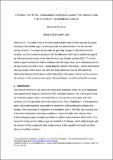The Edict of Pîtres, Carolingian defence against the Vikings, and the origins of the medieval castle
Abstract
The castle was one of the most characteristic features of the western European landscape in the Middle Ages, dominating social and political order from the eleventh century onwards. The origins of the castle are generally assigned to the ninth and tenth centuries, and the standard story begins with the defensive fortifications established against the Vikings during the reign of the West Frankish king Charles the Bald (843–77). In this article I argue that there are serious problems with this origin story, by re-evaluating some of the key sources on which it rests – particularly the Edict of Pîtres (864). I seek to demonstrate that my analysis of this source has important implications for how we think about the relationship between fortifications and the state in the Carolingian Empire; and by extension the evolution of the castle in north-western Europe between the ninth and twelfth centuries.
Citation
MacLean , S 2020 , ' The Edict of Pîtres, Carolingian defence against the Vikings, and the origins of the medieval castle ' , Transactions of the Royal Historical Society , vol. 30 , pp. 29-54 . https://doi.org/10.1017/S008044012000002X
Publication
Transactions of the Royal Historical Society
Status
Peer reviewed
ISSN
0080-4401Type
Journal article
Collections
Items in the St Andrews Research Repository are protected by copyright, with all rights reserved, unless otherwise indicated.

